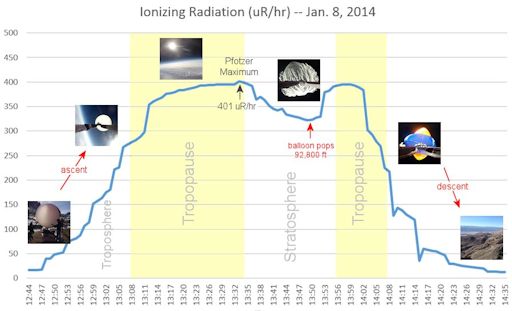QUIET SUN: With no sunspots actively flaring, the sun's x-ray output has flatlined. Solar activity is low and likely to remain so for the rest of the weekend. Solar flare alerts: text, voice
SPACE WEATHER BALLOON LAUNCH TODAY: The students of Earth to Sky Calculus are only hours away from launching another space weather balloon. The launch, slated for midday Pacific time on Jan. 25th, is the latest in a series of suborbital balloon missions designed to study the effects of solar activity on Earth's upper atmosphere. Today's flight samples a period of low solar activity, the opposite of their previous flight, which flew into the teeth of an S2-class solar radiation storm. Here are the storm data they gathered on Jan. 8th:
The curve traces the amount of ionizing radiation encountered by the balloon during its 2 hour flight. During the ascent, an onboard x-ray/gamma-ray sensor measured doses 25 times greater than at ground level. The peak occured at the entrance to the stratosphere in a zone known as the "Pfotzer Maximum." Named after physicist George Pfotzer, who discovered the peak using balloons and Geiger tubes in the 1930s, the Pfotzer Maximum is produced by energetic particles hitting Earth's atmosphere, creating a spray of subatomic debris at high altitudes. The Earth to Sky campaign aims to find out, among other things, how the Pfotzer Maximum moves around in response to solar storms.
This weekend's flight will repeat the Jan. 8th experiment using the same equipment while no solar radiation storm is in progress. If all goes well, the balloon will also capture dramatic images of California's epic drought. Stay tuned for updates.
Realtime Space Weather Photo Gallery
BRIGHT, NEARBY SUPERNOVA: Approximately 12 million years ago, a white dwarf star in galaxy M82 exploded. A few days ago, light from the supernova finally reached Earth. Amateur astronomers can see it through backyard telescopes as a fireball of magnitude +11. Indeed, it is so bright that small telescopes can be used to study the specturm of the blast. David Strange sends these data from Branscombe, East Devon, UK:
"I used a 9-inch Celestron telescope and a Star Analyzer 100 to record the supernova's colors," says Strange.
His data show a strong absorption line corresponding to ionized silicon. Silicon is one of the products of fusing carbon and oxygen, and a telltale sign that this is a Type 1a supernova explosion. Type 1a supernovas are famous in part because they led to the discovery of Dark Energy in the universe. (And, yes, we know that "Dark Energy" is shorthand for "we don't know what's going on.")
Although it is 12 million light years away, M82 is considered to be a next-door neighbor of the Milky Way. Indeed, this is the nearest supernova to Earth since SN 1993J was observed 21 years ago. The relative proximity of the blast makes it an attractive target for astronomers to study. Light curves from previous Type 1a supernovas suggest that the fireball could continue to brighten for the next two weeks. If you have a GOTO telescope, this evening command it to slew to the "cigar galaxy" or "M82," and watch the explosion unfold.

Solar wind
speed: 358.6 km/sec
density: 2.8 protons/cm3
explanation | more data
Updated: Today at 1403 UT
X-ray Solar Flares
6-hr max: B7 1341 UT Jan25
24-hr: C1 0233 UT Jan25
explanation | more data
Updated: Today at: 1400 UT
![]()
Daily Sun: 25 Jan 14
None of these sunspots is actively flaring. Solar activity is low. Credit: SDO/HMI
![]()
Sunspot number: 150
What is the sunspot number?
Updated 25 Jan 2014
Spotless Days
Current Stretch: 0 days
2014 total: 0 days (0%)
2013 total: 0 days (0%)
2012 total: 0 days (0%)
2011 total: 2 days (<1%)
2010 total: 51 days (14%)
2009 total: 260 days (71%)
Update 25 Jan 2014
The Radio Sun
10.7 cm flux: 136 sfu
explanation | more data
Updated 25 Jan 2014
![]()
Current Auroral Oval:
Switch to: Europe, USA, New Zealand, Antarctica
Credit: NOAA/POES
![]()
Planetary K-index
Now: Kp= 1 quiet
24-hr max: Kp= 3 quiet
explanation | more data
Interplanetary Mag. Field
Btotal: 4.7 nT
Bz: 4.1 nT south
explanation | more data
Updated: Today at 1403 UT
![]()
Coronal Holes: 25 Jan 14
There are no large coronal holes on the Earthside of the sun. Credit: SDO/AIA.





